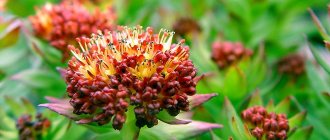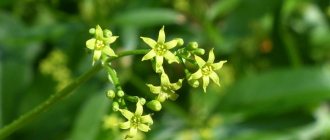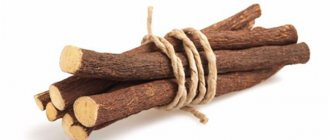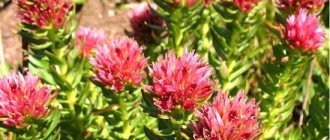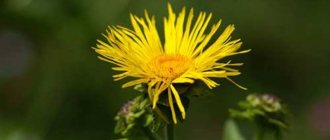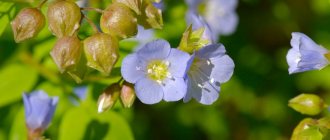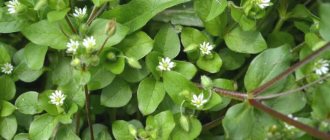Tea kopechnik (forgotten, alpine) is a medicinal plant listed in the Red Book, belongs to the genus Kopeechniki from the Legume family. It grows mainly in mountainous areas, preferring rocky slopes of the subalpine zone. Distributed in Altai, Siberia, the northern side of Mongolia, China, and the Central Asian republics.
The grass has almost bare stems with crimson or lilac racemose inflorescences. Honey-bearing flowers appear in early summer, and by the end of July fruits - dry beans - are formed. Paired oval-shaped green leaves are located at the base of the stems. Adult representatives of the species grow 30-80 cm in height, and the powerful rhizome goes 3-7 meters into the ground.
Alpine pennyweed (Hedysarum alpinum)
Forgotten pennyweed (Hedysarum neglectum)
The fruits of the forgotten kopeck (not eaten)
For its bright color and healing qualities, the plant was called red, bear and male root. In the article we will tell you what medicinal properties alpine kopek has, and we will describe its beneficial and harmful qualities. Let's consider methods of application in medicine.
Medicinal and beneficial properties
The red root, the medicinal properties of which are still being studied, is used in pharmacology and folk medicine to make alcoholic tinctures, decoctions, powders, and tablets against a number of diseases.
The use of drugs based on it is beneficial for the body:
- Normalizes blood pressure with a slight increase.
- Stimulates blood flow and prevents thrombus formation.
- Liquefies mucus and facilitates elimination.
- Stops hemoptysis in tuberculosis.
- It has an antipyretic effect in inflammatory diseases of the respiratory organs caused by cold and flu viruses.
- Calms the nervous system, helps fight stress, depression, apathy.
- Cleanses the blood and liver from toxic compounds.
- Participates in the formation of new blood cells.
- Helps increase the endurance of the heart muscle.
- Tones and strengthens the intestinal muscles, preventing rectal prolapse.
- Improves peristalsis, eliminates spastic pain, relieving inflammation in the gastrointestinal tract.
- Normalizes stool.
- Accelerates recovery from diseases of the urinary system.
- Active in the treatment of oncopathologies.
- It has a positive effect on the female and male reproductive system, helps get rid of infertility, cure a number of disorders of the pelvic organs, and increase sexual activity of both sexes.
- Strengthens the immune system.
- Due to the content of antioxidants, it slows down age-related changes and ensures rapid tissue regeneration.
An extract from flowers, shoots, and leaves of the plant is occasionally used in cosmetology, but the main beneficial properties of the red root are concentrated in the underground part of the same name.
Species and habitat
In total, there are about 300 varieties of plants in nature. Up to 130 species have been recorded in the CIS, 45 of them have been studied and included in reference books, dictionaries and encyclopedias. The most famous species are the yellowish kopek, alpine.
The natural growth zone is spacious steppes, meadows, forests and tundras, mountain slopes, highlands, and river valleys.
The generic and specific name of Kopeechnik is characteristic; it acts as a kind of guide, defining the plant’s habitat zone:
Siberian pennyweed (alpine) grows in the European part of Russia, Siberia, the Far East, and Northern China.
Arctic pennyweed grows in the Far East.
South Siberian - in Altai and Siberia.
The Crimean Kopeechnik is found in the Crimea, the Caucasus and the Balkans.
Reference. The large-flowered and grey-headed pennywort are listed in the Red Book of Russia as endangered species and are protected by the state.
Contraindications and possible harm
Products based on pennywort have contraindications:
- Individual intolerance.
- Acute cardiac, liver or kidney failure.
- History of myocardial infarction.
- Pregnancy.
- Breast-feeding.
- Traumatic brain injury.
- Thrombophlebitis.
- Acute cholecystitis.
- Severe mental illness.
- Alcohol addiction (for alcohol tinctures).
- Chronic arterial hypertension (with blood pressure above 160/100 mm Hg).
- Childhood, adolescence.
The fruits of the tea plant (not eaten)
The components of the plant actively interact with various types of antibiotics, enhancing the effect. To avoid negative reactions, coordinate the simultaneous use of medications and red root with your doctor.
With a slight overdose of Siberian herb, as with long-term use, significant harm is caused to the body.
Violation of the rules of administration causes side effects:
- Insomnia.
- Nervous excitability.
- Anxiety.
- Unreasonable irritability.
- Swelling.
- Hepatic, renal colic.
- Allergic rash.
- Angioedema.
- Migraine.
If symptoms occur, seek emergency medical attention.
Sometimes tea kopeck is mistaken for Korean red ginseng root, but the appearance, benefits and harms of these plants are different. They do not belong to the same genus or family.
Composition, calorie content per 100 g, glycemic index and nutritional value
After receiving a portion weighing 100 g, the body absorbs 230 kcal . If consumed in the form of syrup with sugar, the value will be much higher.
Analysis of energy value: zero fat content, 0.2 g of protein and from 30 to 65 g of carbohydrates (depending on the form of the product).
Components of a penny:
- vitamin C, mangiferin;
- alkaloids, polysaccharides;
- amino acids;
- tannins, flavonoids;
- hedysaride, microelements.
The glycemic index is 30 , a moderate value that can sometimes cause a slight increase in blood glucose levels.
Do you know how lungwort is useful for women? How to use this plant? Our article will give you answers to your questions.
You can read about the medicinal properties and contraindications to the use of alfalfa in this material.
The benefits and harms of the spice called cloves are discussed in this publication. Find out more!
Features of use for men and women
The composition allows the red root to be used in gynecology and andrology. It copes with reproductive dysfunctions.
Benefits of herbs for women:
- Eliminates uterine bleeding.
- By normalizing hormonal levels, it reduces nervousness.
- Helps with infertility, replenishes the lack of estrogen.
- Prevents osteoporosis that occurs during menopause.
- Stabilizes a woman’s condition during menopause, reduces the frequency of hot flashes.
- Helps cure erosion, endometriosis.
- Eliminates vaginal dryness, stimulates secretion.
- Restores the menstrual cycle.
- Prevents prolapse and prolapse of the uterus by strengthening smooth muscles.
- Prevents the formation of myomas and fibroids.
- Actively fights cancer cells in breast cancer pathology.
- Helps with mastitis.
- Positively affects skin condition.
- Prevents hair loss.
- Increases sexual desire.
It’s not for nothing that kopeck is called a male root - its use is useful for representatives of the stronger sex suffering from ailments of the genitourinary system.
Indications for use of red root for men:
- urethritis;
- BPH;
- urinary retention;
- erectile disfunction;
- infectious diseases accompanied by inflammation and acute pain;
- infertility.
Kopechnik increases blood flow to the genitals and increases the desire for physical intimacy. However, use as an aphrodisiac must be approved by a physician. He will establish a dosage regimen and determine the dosage.
What is useful, indications for using the herb
Fresh grass has similar properties as dried grass.
Effect on the body:
- genitourinary system . Inflammation goes away, stones are removed faster;
- CNS . Apathy, dizziness, depression are eliminated;
- immune _ The body's defenses are strengthened;
- vascular _ The elasticity of blood vessels and capillaries increases (vasoprotective effect).
In the presence of chronic fatigue, this plant quickly restores the body.
Kopeechnik is a honey plant. Considered a good forage plant for livestock.
Chemical composition
The benefits of red root are provided by bioactive compounds in the composition. Chemical analysis of the rhizome of the pennywort showed the concentration of the following substances:
- Estrogen is a steroid sex hormone produced by the ovarian follicles in women and the testicles in men. Responsible for the full development and functioning of the genital organs.
- Flavonoids are plant pigments that provide the rich color of the root. They improve the elasticity of red blood cells, slow down blood clotting, strengthen the walls of capillaries, and have antispasmodic properties.
- Catechins are substances that belong to the class of flavonoids. They have antitoxic and antitumor effects.
- Saponins are organic compounds that accelerate the penetration of proteins through cell membranes. They are diuretics and promote rapid absorption of drugs. They have an antisclerotic, antiulcer, laxative effect.
- Xanthones are powerful plant antioxidants. They prevent mutations in the DNA chain, are able to relieve inflammation, and have an antimicrobial and antitoxic effect. Strengthens the cardiovascular system.
- Tannins are astringent compounds that have disinfectant properties. They help eliminate diarrhea and normalize intestinal microflora.
- Coumarins are organic elements with antitumor activity. Strong anticoagulants, relieve spastic pain.
The red root contains ascorbic acid, as well as a number of macro and microelements:
- iron;
- magnesium;
- calcium;
- potassium;
- zinc;
- manganese;
- selenium;
- strontium, etc.
Potential Hazards and Precautions
It is prohibited to use other adaptogens during the course of treatment with a decoction , which together can lead to hyperactivity.
Taboo on taking penny:
- high blood pressure;
- previous heart attack;
- arrhythmia;
- thrombophlebitis;
- damaged brain;
- liver and kidney failure.
For persons prone to a sharp increase in excitability , taking plant-based herbal products is not recommended. Insomnia, hysterics, irritability are possible consequences of taking the course.
Despite the ability of kopeck to dissolve stones and promote their passage, it is dangerous for patients diagnosed with large formations .
Getting stuck in the canals, they provoke obstruction, inflammation and there is no alternative to surgical intervention.
Warning : red root should not be combined with taking antibiotics.
What are the benefits of fennel for women? Read our article.
The beneficial properties of fenugreek seeds are discussed in this publication.
You can learn about the benefits and harms of rosemary for humans from this publication.
Pharmaceutical products, release form
Pharmacies offer products where penny is an active ingredient. There are several forms of release:
- pills;
- capsules;
- powder;
- alcohol solution for oral administration;
- tea;
- herbal collection;
- balm.
All of the above products are considered dietary supplements. Despite their healing properties, they are not officially a medicine, although they are recommended by medical practitioners.
Popular and effective preparations based on tea pennyweed:
- tincture "Effex Red Root";
- balm “Tales of Altai”;
- Milona-5 tablets with phytocomplex for women;
- tablets "Milona-11" for men's health;
- tea drink “Kopeechnik”;
- capsules.
Evalar, one of the leading manufacturers of dietary supplements on the domestic pharmacological market, specializes in the production of such products. The company's products have 90% positive reviews.
You can buy dietary supplements without presenting a prescription, but in order not to harm yourself, you should first obtain medical advice and instructions for use. The dosage, frequency of administration, and duration of treatment depend on the initial diagnosis, release form, and the amount of active substance in the drug.
Pharmacological properties
- The symbiosis of active compounds in the composition has an antiviral effect, effectively copes with influenza, colds, herpes type 2, and urinary tract infections.
- Red root has immunomodulatory, antioxidant, anticoagulant, and antibacterial properties.
- Prevents congestion in the prostate gland and promotes its disappearance.
- Prevents the development of inflammation in the bladder. Ensures complete emptying and reduces the frequency of the urge to urinate. Due to this quality, it is used in complex therapy of prostatitis and enuresis in adults.
- Improves blood circulation in the pelvic area, which helps increase potency in men. Normalizes hormonal levels, eliminates disorders of the reproductive system, increases the ability to conceive.
- Stimulates the functioning of the heart, respiratory organs, and central nervous system.
Botanical description, homeland and distribution
Kopeechnik (from the Latin Hedusarum - literally - pleasantly smelling) belongs to the large legume family. Several generic varieties are found in nature - mainly perennial herbaceous plants, subshrubs and shrubs.
Interesting. The scientific name for the plant was given by the famous Swedish naturalist, Carl Linnaeus in the 18th century. He also introduced Kopeechnik into the unified classification of flora and fauna.
In Ukraine, the plant is commonly called Solodushka for its spicy aroma and nectar. Russian folk analogues of the names of Kopeechnik are Gedizar, Baduy, Sardana, Red Root, Denezhnik.
The plant's beans are round, slightly elongated, elliptical in shape. The bean fruits are constricted transversely, slightly pubescent, pendulous, and consist of 2-5 flat segments.
The root system is powerful and thickened. The root is woody, taprooted, and goes deep into the soil, which increases the plant’s tolerance to arid climates.
The stems are tall, there are branched, branching and erect species. The length of the stem reaches up to 80 cm. The flower arrow emerges from the shoots. The shoots are shortened and develop at the basal neck.
The stipules are brown in color, scaly, large, fused together. There are 4-10 leaves on short petioles arranged in pairs on the stem. The leaves, depending on the species, are oval, rounded, ovoid in shape. The leaf blade along the edges, below and along the main vein is slightly pubescent with short hairs.
Peduncles are longer than the leaves and are located at the top of the stem. The flowers are bright, fragrant, purple or lilac in color, collected in loose clusters of 15-30 pieces.
The seeds are small, up to 3 mm, olive-brown in color.
Use in folk medicine, recipes
Red root was used by healers to treat and prevent many ailments. Thanks to traditional medicine recipes, it is possible to prevent and cure pathologies of various organs.
Cardiovascular disordersKopeck is effective against dropsy of the heart, rheumatism, deep vein thrombosis. If there is a hereditary tendency to diseases of the blood vessels and heart, it is worth thinking about preventive measures. An herbal infusion is considered an effective remedy.
To prepare you will need:
- kopeck tea root – 2 tbsp;
- currant leaf – 2 tbsp;
- peppermint – 2 tbsp;
- marsh wild rosemary - 2 tbsp;
- water – 500 ml.
Preparation:
- Mix all the herbs and put them in a thermos.
- Pour boiling water over it.
- We insist 12 hours.
- We filter.
The infusion should be drunk warm, ½ cup 4 times a day.
Pathologies of the respiratory system For influenza, pneumonia, bronchitis, and colds, pennyweed liquefies viscous secretions, facilitates expectoration, and accelerates the transition from a dry cough to a productive one. Stopping hemoptysis in pulmonary tuberculosis.
Decoction recipe:
- Place 15 g of crushed root in an enamel bowl and add 300 ml of warm water.
- Cover with a lid and place in a water bath for half an hour.
- Strain and add a little boiled water to get the original volume.
- Bring to a boil.
Drink 2 tablespoons of the cooled product. 3 times a day before meals. Store in the refrigerator for up to 3 days.
Diseases of the male genitourinary system For urethritis, prostatitis, pain during erection or ejaculation, alcohol-based products are most effective. The most prescribed drug is the “Red Root Plus” tincture from Evalar.
The active components are pennyweed in combination with knotweed herb. This complex has a diuretic effect, slows down the absorption of salts, relieves inflammation and swelling.
Red root tea
To gain a supply of vigor, replenish energy and physical strength, it is recommended to drink a tea drink made from red root. According to legends, bears dug up and ate kopeks to restore strength after hibernation.
Prepare the healing infusion:
- Mix 1 tbsp. dry crushed root and 1 tsp. black tea leaves.
- Pour 400 ml of boiling water.
- Let it sit for 20 minutes.
- Add sweetener.
Instead of black tea, green tea is suitable. It is recommended to drink twice a day, 7-10 days.
Decoction recipe
Make herbal infusions only in a water bath, otherwise half of the nutrients will be lost. We offer a recipe widely used in folk medicine for the prevention of malignant and benign tumors.
Preparation:
- Fill a saucepan with water and place it on the stove.
- Pour the grass into a large enamel bowl and add 1 liter of water.
- Place in a water bath and cover tightly with a lid.
- Simmer over low heat for 40 minutes.
- Pour the hot broth into a thermos.
- Leave for 12 hours, strain, cool.
The resulting product is suitable for washing, douching, and enemas.
Red root tincture with vodka
Method for preparing homemade tincture.
You will need:
- vodka 40% - 0.5 l;
- dried kopeck root - 2 tbsp.
Cooking method:
- Pour the prepared raw materials into a dark glass bowl and fill with vodka.
- Close tightly with a nylon lid and put it in a cool, dark place.
- Shake daily.
- After 2 weeks, strain.
If there is no dark glass container, wrap a simple jar with thick cloth so that it does not let in light.
The recommended dose for use is 40 drops diluted in water, 3 times a day before meals. Depending on the nature of the disease, the therapeutic course lasts from 7 to 30 days.
Red root: history of use
From time immemorial, healers of Siberia, residents of the Altai Territory and the Sayan Mountains have used infusions and decoctions of the red root in the treatment and prevention of many diseases. It was added to tea, which was used to warm up and heal. Therefore, tea was added to the main name - kopeechnik.
This plant has other names: bear root or bear root, white root, blood root. The latter name comes from the deep red color of the root, which resembled blood.
Chinese tea: Pexels
But the names that are associated with the bear are rooted in ancient legends and beliefs. Hunters believed that the roots of the kopeck in early spring became the main food of bears waking up from hibernation. In this way the forest owner regains his strength. These animals also dig it up in case of illness.
There was a legend that the red root was a gift from a bear to people. Since ancient times, people have been looking for a heavenly place on earth - Belovodye. It was believed that happiness and prosperity reigned there, there were no diseases. People wandered in the mountains in search of this mysterious place, and evil spirits sent illnesses to them. Then the bear brought the people a plant with a blood-red root. Tea brewed with this plant became healing.
People have noticed that drinks with kopeck root perfectly tone up and speed up metabolic processes in the body. In this way they were saved from fevers and colds, and the kidneys and digestive organs were treated.
Echinacea: Pexels
It is believed that the red root, like radiola rosea, is a means of prolonging life. Decoctions with it give strength, make people active, more resilient, and lift their spirits. In Chinese medicine, white root is considered an excellent sedative. Therefore, it is used to treat epilepsy and nervous disorders.
In addition to decoctions, the red root is used in enema solutions; various solutions and tinctures are made from it. Today, kopek can be bought at the pharmacy. Drugs derived from it are also sold there. They are used in the complex treatment of a number of diseases.
Features of collecting and procuring raw materials
The collection of roots begins after the seeds appear, when the pennyweed fades. Usually this is mid-August.
There are strict conditions:
- The plant must be mature, more than 40 cm in height.
- Dig carefully, take up to 1 meter of root.
- A new collection can be made in the same place after ten years. During this time, the grass is completely restored.
The collected roots are washed from dirt, cut into long slices, then laid out in a thin layer on plastic film or paper. Dry raw materials outdoors in the shade, avoid sunlight. If this is not possible, a well-ventilated room will do.
After drying, the kopeck is placed in a cotton bag and stored in a dark place for up to 3 years.
Where to get raw materials
Dried penny root can be purchased at a pharmacy, since its growing area is limited. The roots are not easy to extract - they go about 5 meters deep. They are harvested industrially in early autumn, then the clearing is left for 10 years to restore the plant population. The price of raw materials in the pharmacy is 145 rubles per 30 g.
Forgotten pennyweed root powder
The root of the forgotten kopeck can be bought on websites at a price of 150 rubles per 50 g. The root of the tea kopeck can be ordered here: https://global.altaimatri.ru/product/krasnyj-koren/ at a price of 150 rubles for 50 g.
Application in cosmetology, research
In 2021, Italian scientists conducted experiments aimed at identifying the effect of plants from the Kopeechnikov genus on the condition of the skin. The goal is to establish the feasibility of using extracts for the production of cosmetic and dermatological creams.
Based on the results of the study, conclusions were drawn about the effectiveness of using herbal extracts to combat such skin problems as:
- dryness;
- cracks;
- withering;
- cellulite;
- inflammation;
- redness.
A noticeable influence of the geography of legume growth on the content of useful substances was also noted. The highest concentration is observed in the Altai kopeck extract.
Brief introduction
This is a very specific type of root, six years old. The color is not always red, it can vary from light yellow-beige to brown-red.
In order to preserve its beneficial properties, it is processed in a special way: after exposure to steam, it is dried in air, it is protected from sunlight. This drug is stored in wooden boxes, wrapped in paper, completely ready for use.
Read about the use of red root for men.
There are several types of this healing plant, each of which is good in its own way:
- Korean, the richest of its fellows in useful substances, saponins;
- Chinese has an excellent calming effect;
- American;
- heavenly, the highest quality type of roots that have undergone careful selection.
What does pennywort look like and where does it grow?
Redroot is a perennial plant belonging to the legume family. It got its name due to the similarity of individual parts of the beans to a coin. The kopek plant has a strong long stem, the height of which reaches 90 cm. It bears odd-pinnate leaves, divided into elongated blunt-pointed lobes. During the flowering period, the kopeck is covered with red, pinkish or white inflorescences. This process occurs from July to August.
The Altai region is considered the birthplace of the red root. Today the plant is found in the Urals, Siberia and the southern part of the Kola Peninsula. It can be found on forest edges, mountain slopes and meadows. The pennywort prefers well-drained soil located in elevated areas. Its distinctive features include the creation of favorable conditions for the growth of other plants. In total, there are about 100 species of pennyweed in nature.
The root of the pennywort goes into the ground to a depth of 5 m
Attention! Thanks to the content of catechin, kopeck is able to remove heavy metals from the body.
